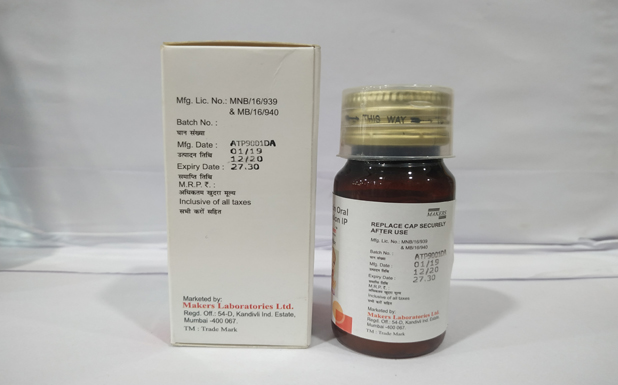Ofloxacin is an antibiotic that belongs to the class of medications called quinolones. It is used to treat certain infections caused by bacteria. It is most commonly used to treat infections of the lung, urinary tract, and skin. It can also be used to treat certain prostate infections and sexually transmitted infections. Ofloxacin works by killing some types of bacteria that can cause these infections.
Each 5 ml contains:
Ofloxacin 50 mg
Suspension
Antibiotic

To reduce the development of drug-resistant bacteria and maintain the effectiveness of ofloxacin tablets and other antibacterial drugs,
ofloxacin tablets should be used only to treat or prevent infections that are proven or strongly suspected to be caused by susceptible
bacteria.
Ofloxacin tablets are indicated for the treatment of adults with mild to moderate infections (unless otherwise indicated) caused by
susceptible strains of the designated microorganisms in the infections listed below
Acute Bacterial Exacerbations Of Chronic Bronchitis:
due to Haemophilus influenzae or Streptococcus pneumoniae.
Community-acquired Pneumonia:
due to Haemophilus influenzae or Streptococcus pneumoniae.
Uncomplicated Skin And Skin Structure Infections:
due to methicillin-susceptible Staphylococcus aureus, Streptococcus pyogenes, or Proteus mirabilis.
Acute, Uncomplicated Urethral And Cervical Gonorrhea:
due to Neisseria gonorrhoeae. Nongonococcal urethritis and cervicitis due to
Chlamydia trachomatis.
Mixed Infections Of The Urethra And Cervix:
due to Chlamydia trachomatis and Neisseria gonorrhoeae.
Acute Pelvic Inflammatory Disease (Including Severe Infection):
due to Chlamydia trachomatisand/or Neisseria gonorrhoeae.
Ofloxacin is a quinolone antimicrobial agent. The mechanism of action of ofloxacin and other fluoroquinolone antimicrobials involves
inhibition of bacterial topoisomerase IV and DNA gyrase (both of which are type II topoisomerases), enzymes required for DNA
replication, transcription, repair and recombination.Ofloxacin has in vitro activity against a wide range of gram-negative and
grampositive microorganisms. Ofloxacin is often bactericidal at concentrations equal to or slightly greater than inhibitory concentrations.
Fluoroquinolones, including ofloxacin, differ in chemical structure and mode of action from aminoglycosides, macrolides and β-lactam
antibiotics, including penicillins. Fluoroquinolones may, therefore, be active against bacteria resistant to these antimicrobials. Ofloxacin
has been shown to be active against most strains of the following microorganisms both in vitro and in clinical infections.
AEROBIC GRAM-POSITIVE MICROORGANISMS:
Staphylococcus aureus (methicillin-susceptible strains)
Streptococcus pneumoniae (penicillin-susceptible strains)
Streptococcus pyogenes
AEROBIC GRAM-NEGATIVE MICROORGANISMS:
Citrobacter (diversus) koseri
Enterobacter aerogenes
Escherichia coli
Haemophilus influenzae
Klebsiella pneumoniae
Neisseria gonorrhoeae
Proteus mirabilis
Pseudomonas aeruginosaAs with other drugs in this class, some strains of Pseudomonas aeruginosa may develop resistance fairly
rapidly during treatment with ofloxacin
Ofloxacin tablets is contraindicated in persons with a history of hypersensitivity associated with the use of ofloxacin or any member of the quinolone group of antimicrobial agents.
In clinical trials, the most frequently reported adverse events, regardless of relationship to drug, were: nausea 10%, headache 9%, insomnia 7%, external genital pruritus in women 6%, dizziness 5%, vaginitis 5%, diarrhea 4%, vomiting 4%. In clinical trials, the following events, regardless of relationship to drug, occurred in 1 to 3% of patients:Abdominal pain and cramps, chest pain, decreased appetite, dry mouth, dysgeusia, fatigue, flatulence, gastrointestinal distress, nervousness, pharyngitis, pruritus, fever, rash, sleep disorders, somnolence, trunk pain, vaginal discharge, visual disturbances, and constipation.